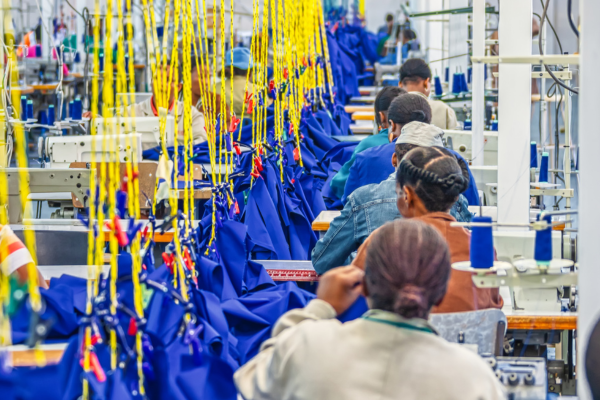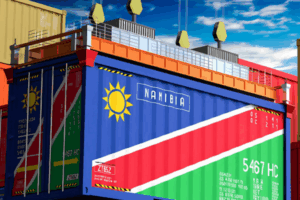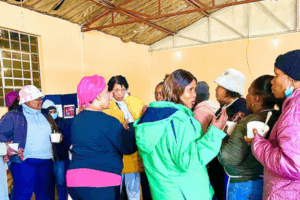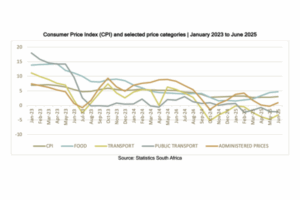Behind the African Continental Free Trade Area (AfCFTA) agreement lies a fundamental question: how can trade serve the people who power it? In the latest episode of A Labour of Love podcast, host Trenton Elsley talks with Etienne Vlok from the South African Clothing and Textile Workers Union (SACTWU) about trade, labour, and industrial policies linked to the AfCFTA.
Trenton Eslely (left) and Etienne Vlok.
A Labour of Love is an LRS podcast about the world of work for civil society and trade union actors.
The AfCFTA aims to create a single market for goods and services across 54 African countries, a game-changer for regional integration and economic growth. The stakes are high for workers, especially those in vulnerable sectors like clothing and textiles. Now is a critical time for trade unions to influence trade and investment policy based on past lessons and future opportunities.
A cautionary tale of liberalisation
South Africa’s experience with trade liberalisation in the 1990s offers lessons. As the country transitioned to democracy, it joined the World Trade Organisation (WTO) and committed to reducing import tariffs. However, its classification as a “developed” country during the Uruguay Round of negotiations resulted in tariff reductions that devastated domestic industries.
"We largely made what we needed… And so at that stage, the industry was much, much bigger than it is now, but it also was not very competitive because there wasn't a huge amount of competition from imports."
Etienne Vlok, National Industrial Policy Officer at SACTWU
The flood of cheap imports, particularly in the clothing and textile sectors, led to factory closures and job losses. Industrial towns like Atlantis in the Western Cape and Dimbaza in the Eastern Cape were particularly hard-hit. Women, who made up most of the workforce, bore the brunt of the economic fallout.
A chance to do it differently
The AfCFTA presents an opportunity to avoid the pitfalls of the past. By promoting regional value chains, it aims to build an interconnected and resilient manufacturing base across the continent. One regional value chain example is the denim industry:
South Africa does not produce denim fabric, but neighbouring Lesotho does. This collaboration enables South African manufacturers to source denim Lesotho, creating jobs and supporting industrial capacity in both countries.
"It is important to understand that it is not just choosing between regional and national value chains. In other words, it is not that every product will be made in several different countries. In some cases, the product may be made only in South Africa or only in Mauritius and in other cases it will be across sectors. So in our dealings with the AfFCTA, it's about looking at individual products and then trying to figure out their competitiveness and linkages into other sectors, and then perhaps not exposing that product to protection, but taking the products we believe we are possibly slightly more vulnerable and excluding them from liberalisation."
Etienne Vlok
Rules of Origin and the AfCFTA
Rules of Origin serve as a ‘passport,’ enabling goods to circulate duty-free within a free trade area as long as they qualify as originating within the FTA. ( UNCTAD, 2019)
Rules of Origin (RoO) are designed to prevent abuse of trade agreements by foreign companies through the illegitimate classification of goods as well as product dumping. These rules are designed to ensure that the economic benefits of trade stay within the continent, supporting local industries and creating jobs.
RoO require that products traded duty-free under the AfCFTA meet specific criteria about where and how they are made. For instance, a woven shirt can only qualify for duty-free trade if the fabric it’s made from is woven or knitted within a participating country.
This system is about protecting the final stages of manufacturing and encouraging deeper industrialisation by promoting upstream industries. The rules help build local value chains, strengthen industrial capacity, and ensure that the economic benefits of trade extend beyond simple assembly processes.
"It’s much like saying in autos: you can’t just benefit from the trade agreement by importing all the parts, screwing them together, and claiming it’s made in South Africa. The same applies here - each component must contribute to local value."
Etienne Vlok
Balancing interests in trade negotiations
While the AfCFTA is in force, negotiations on rules of origin remain ongoing. In the clothing sector, there is a general agreement on a two-stage rule: fabric must be woven or knitted locally for garments to qualify for duty-free trade. However, exceptions for synthetic fabrics are a sticking point.
Balancing the protection of local industries (defensive intrests) with the goal of expanding exports (offensive interests) is challenging. For instance, while some countries push for stricter RoO, others advocate flexibility in sectors where local production capacity is limited.
A key aspect of the AfCFTA is that it allows for certain products to be protected from liberalisation. Countries can protect up to 10% of their product lines: 7% as “sensitive goods” with partial tariff reductions and 3% as fully excluded items with no preferential tariffs. While this approach allows nations to protect vital industries, it also raises questions about its adequacy for countries with established markets like South Africa.
"We think it should have been bigger - possibly up to 15% - to better align with industrial policy. But that egg has been scrambled. Now we are figuring out what to exclude: tracksuits, sleepwear, babywear, or swimwear? It’s about where the jobs are."
Etienne Vlok
In contrast, less developed economies often have smaller local markets and view liberalisation as an opportunity to send more goods to countries like South Africa. For them, offensive interests outweigh defensive ones, creating a diverse landscape of priorities within the AfCFTA.
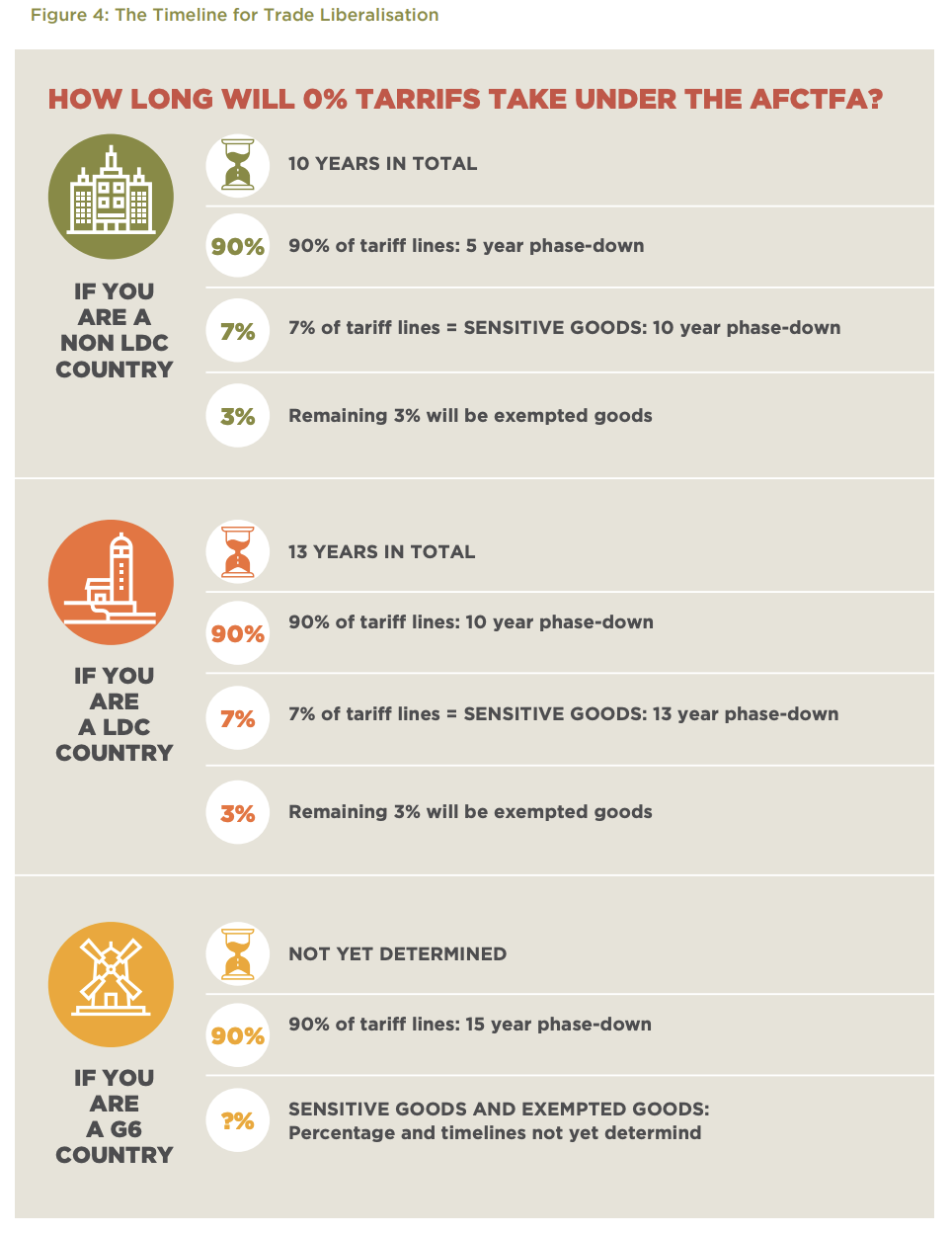
Challenges facing Africa’s clothing manufacturing
Second-hand clothing: Second-hand clothing imports, while affordable for consumers, have devastated local manufacturing. Attempts to ban these imports in East Africa faced pushback from US exporters, who argued such restrictions violated trade agreements. Although the AfCFTA excludes second-hand goods from preferential terms, enforcement remains a hurdle.
Fast fashion: Offshore online retailers introduce a troubling paradox. Companies like Shein and TEMU offer affordable, convenient options but perpetuate exploitative labour practices, environmental degradation, and unfair competition for local industries. Unlike traditional retailers, these offshore companies bypass import systems by shipping individual packages directly to consumers. This model erodes tax revenues, undermines local businesses, and floods markets with low-quality, unsustainable garments that quickly end up in landfills.
"Behind it, there is downgraded manufacturing experience, the quality of the job, the conditions under which the materials are made...all of that is downgrading at the same time as this consumer experience is an incredible one."
Etienne Vlok
Inadequate investment in upstream industries: Deepening industrialisation requires investment in capital-intensive upstream industries like fabric weaving, yarn spinning, and dyeing.
These upstream industries create stability in the sector. Without them, clothing factories can easily relocate to other countries offering better incentives, as seen when Ethiopia’s government-supported factories moved to Tanzania. However, with a robust upstream industry in place, countries can anchor manufacturing operations locally, ensuring long-term industrial growth and job retention.
Vlok cites the role of South Africa’s Industrial Development Corporation as a model for funding industrial growth, suggesting that similar institutions across the continent could anchor manufacturing operations locally and create long-term stability.
Trade administration: Fraud, smuggling, and misdeclaration of goods pose significant risks to the AfCFTA. Without effective trade administration, these issues could undermine its benefits. Without effective enforcement, traders can exploit loopholes, undermining the benefits of the AfCFTA.
"We are worried that we are making all kinds of special rules and designating certain products for exclusion and not others. We are worried about the ability of the governments and the customs services to deal with those at the harbour. And I say that based on our own experience with customs fraud at our harbours. We know there have been discussions at the African Union level and the AfCFTA level about this, but we are concerned."
Etienne Vlok
Trade unions, trade and the AfCFTA
Trade unions have a role in shaping trade policy but must be well-prepared, organised and persistent to influence discussions.
"The more members I have, the easier it is for me to insist on having a place at the table and to provide a view on whether an agreement works or whether trade benefits our members."
Etienne Vlok
Key actions for unions:
- Understand your industries to advocate effectively for worker protection.
- Claim a seat at the table to ensure your voices are heard in policy spaces.
- Strengthen organising efforts to amplify your influence.
The AfCFTA offers a vision of interconnected economies, thriving industries, and shared prosperity. Realising this potential requires inclusive industrial policies and tools, strong enforcement, and active participation from all stakeholders, particularly workers.
Tune in to this episode of A Labour of Love on Spotify or YouTube to learn more about trade, the AfCFTA and how trade unions can shape trade policy.
Episode 3: Crossing Threads: The Voice of Trade Unions in African Integration
For further insights, check out the country trade fact sheets and a guide to the AfCFTA protocol on trade in goods and more on www.tradeunionsinafcfta.org, a knowledge hub for unions advocating on the AfCFTA.
Let’s reimagine trade together.


